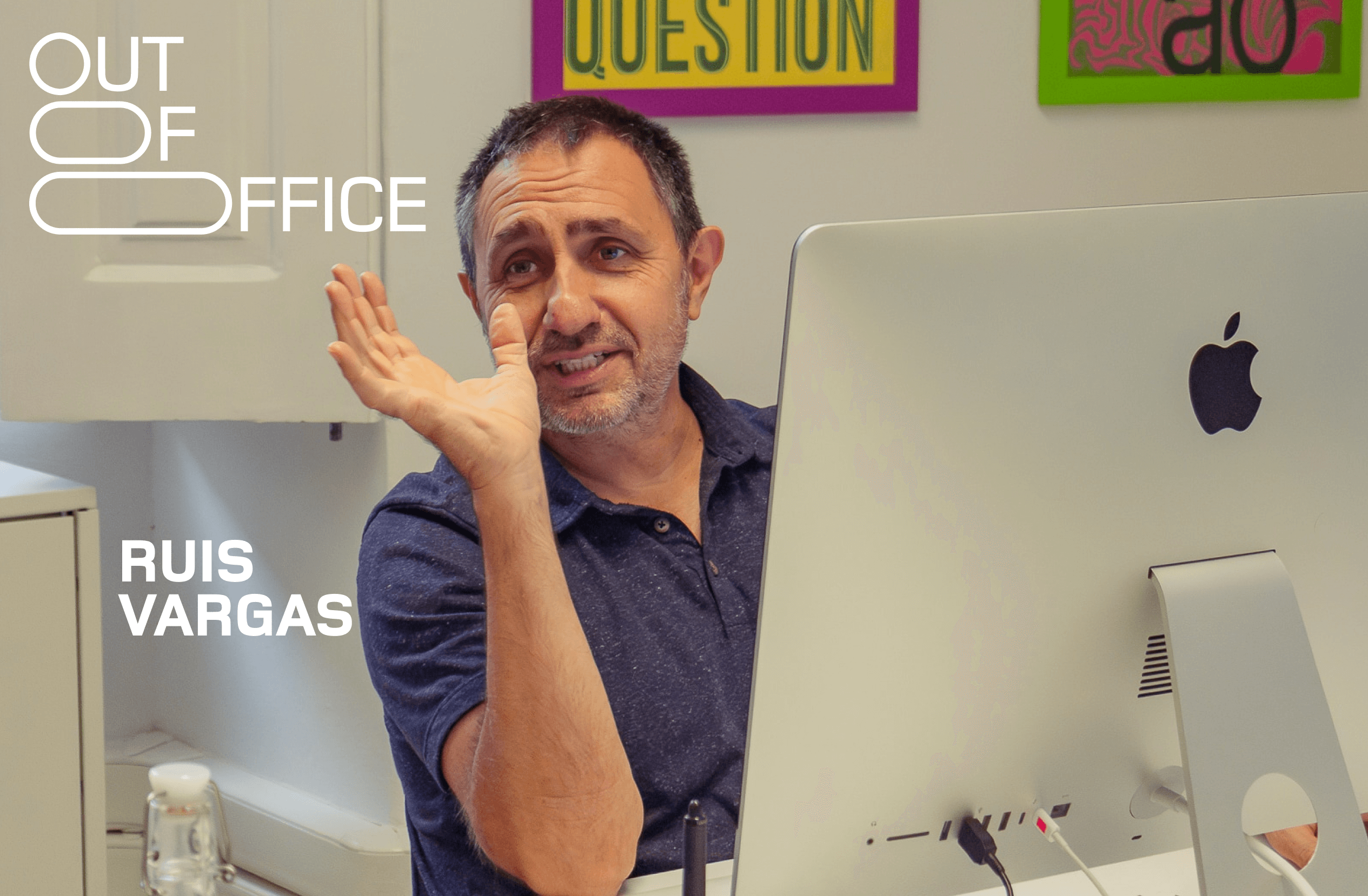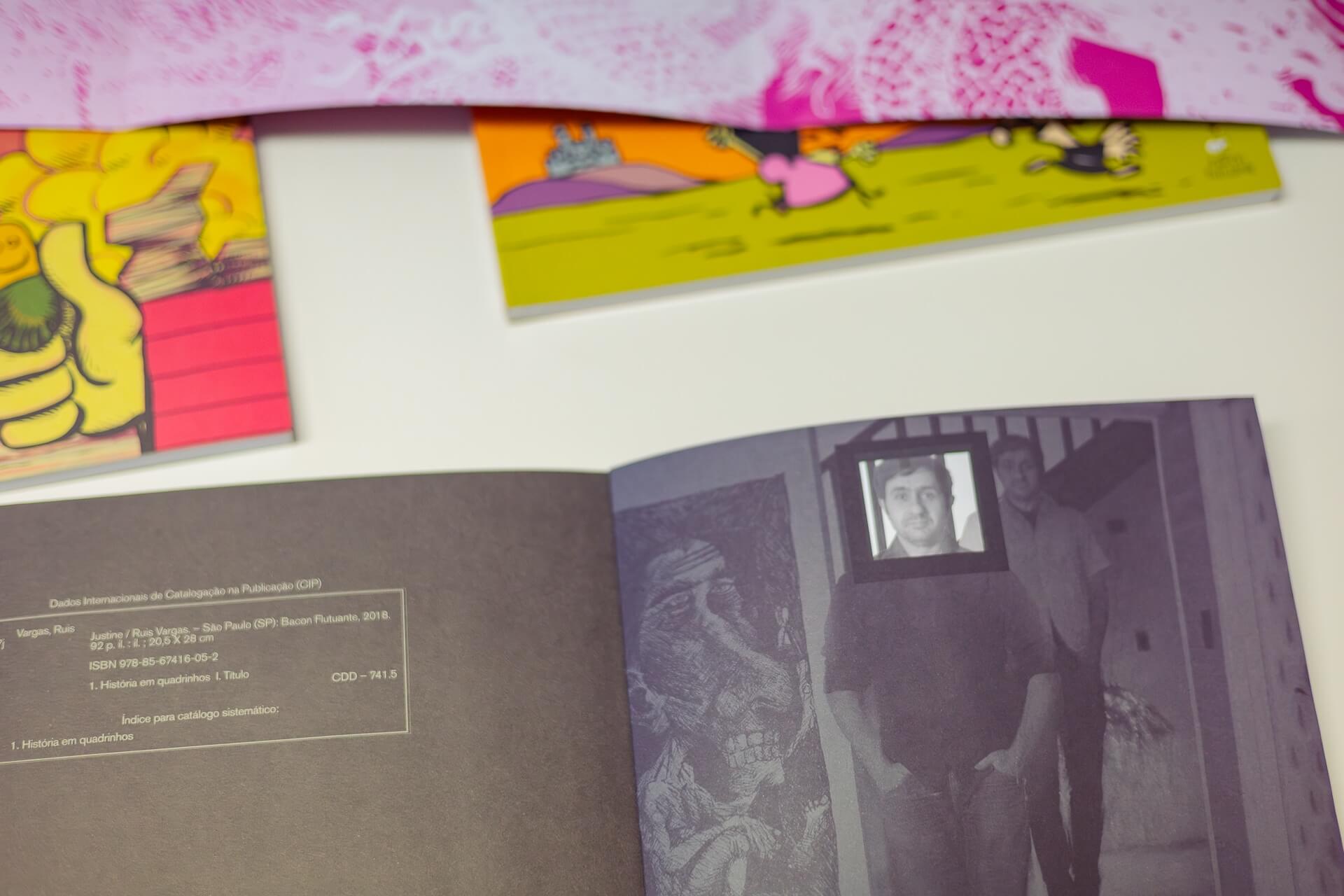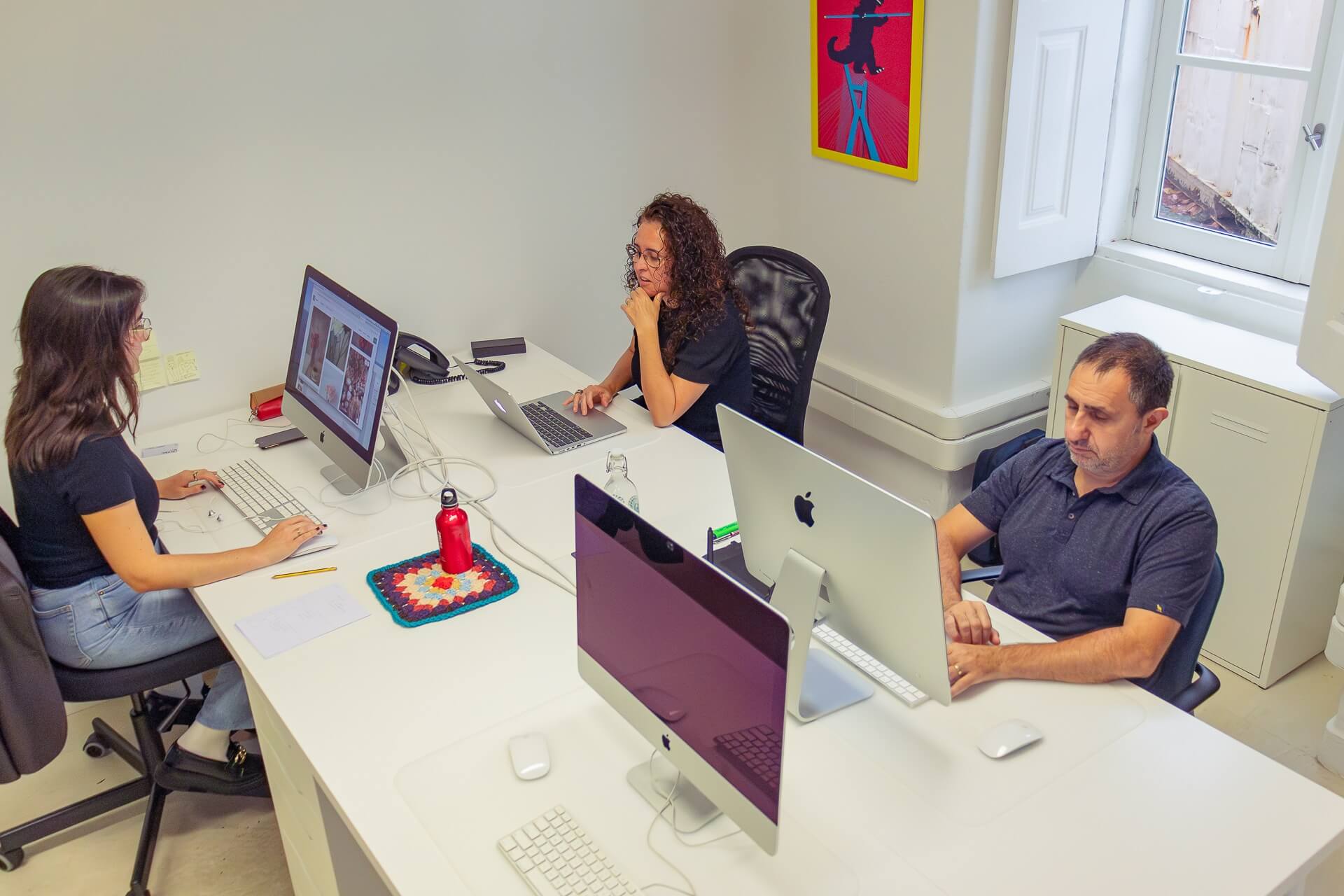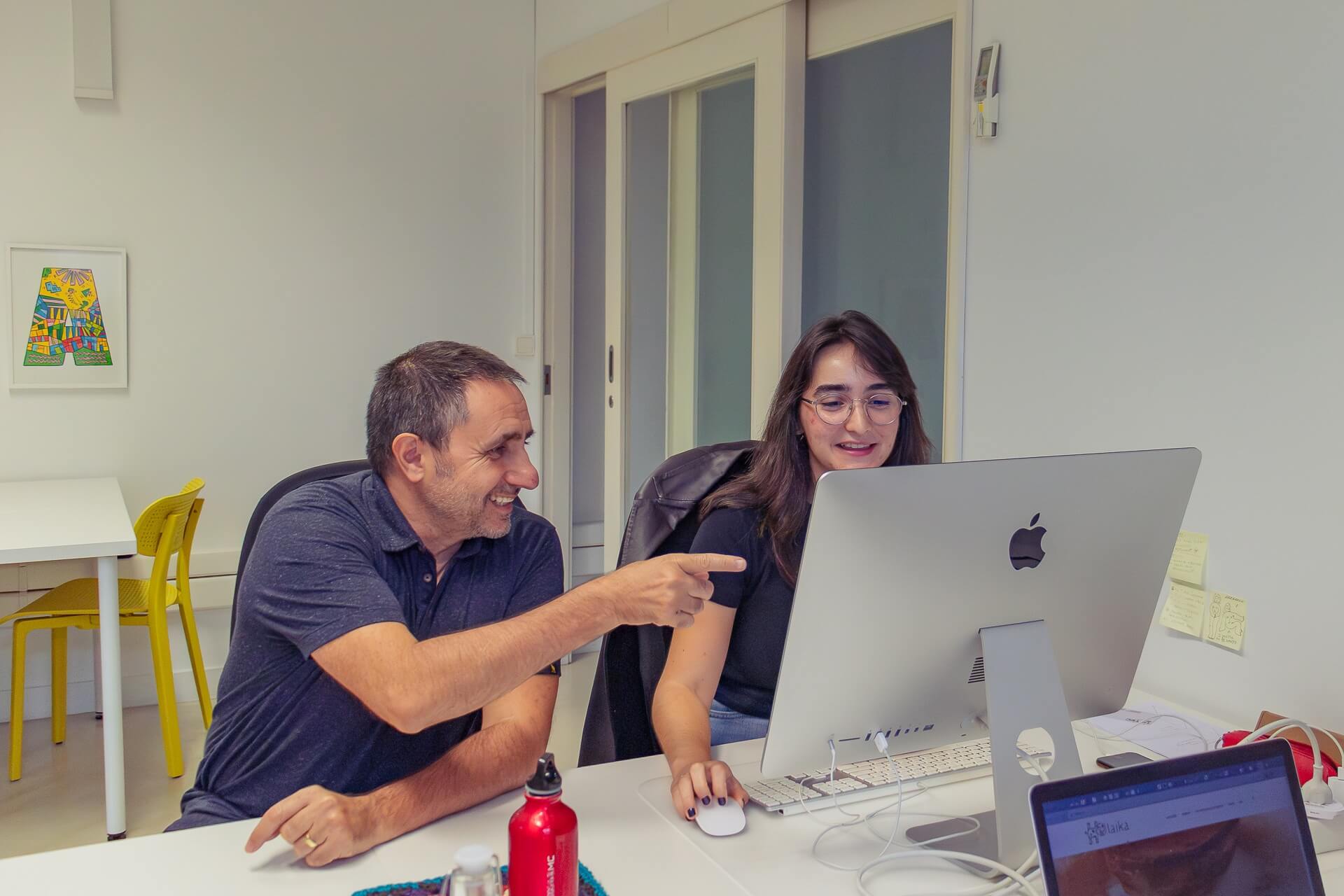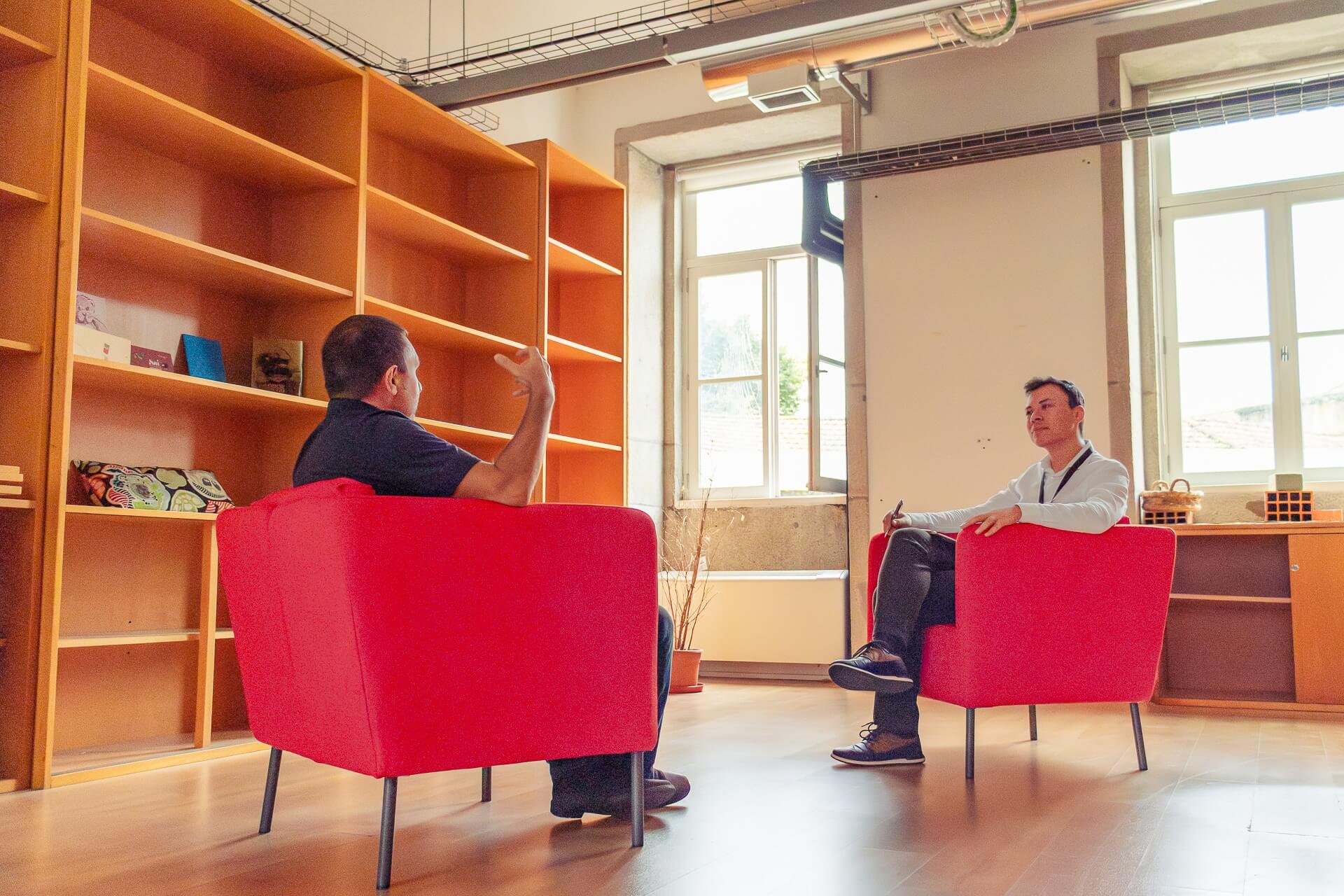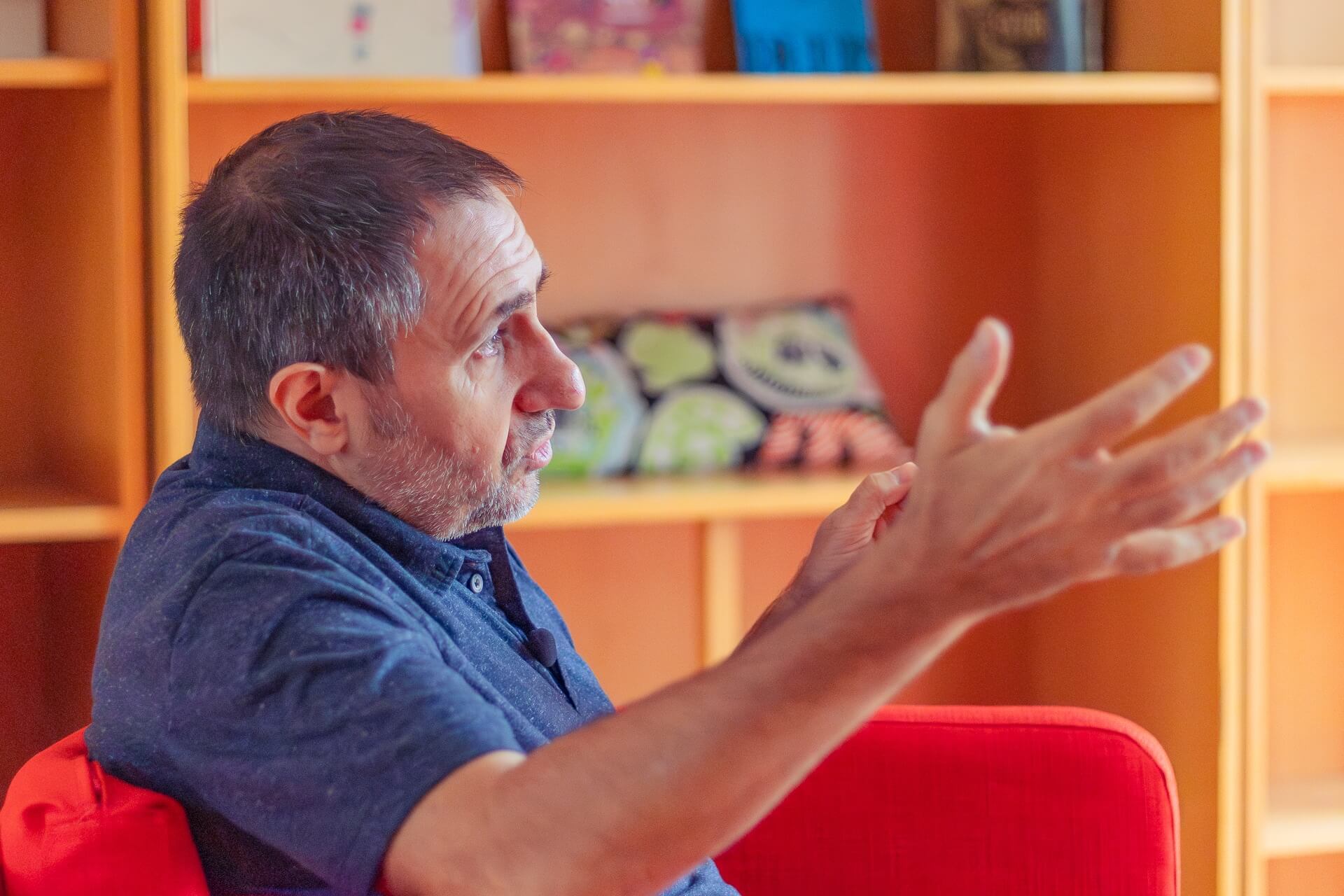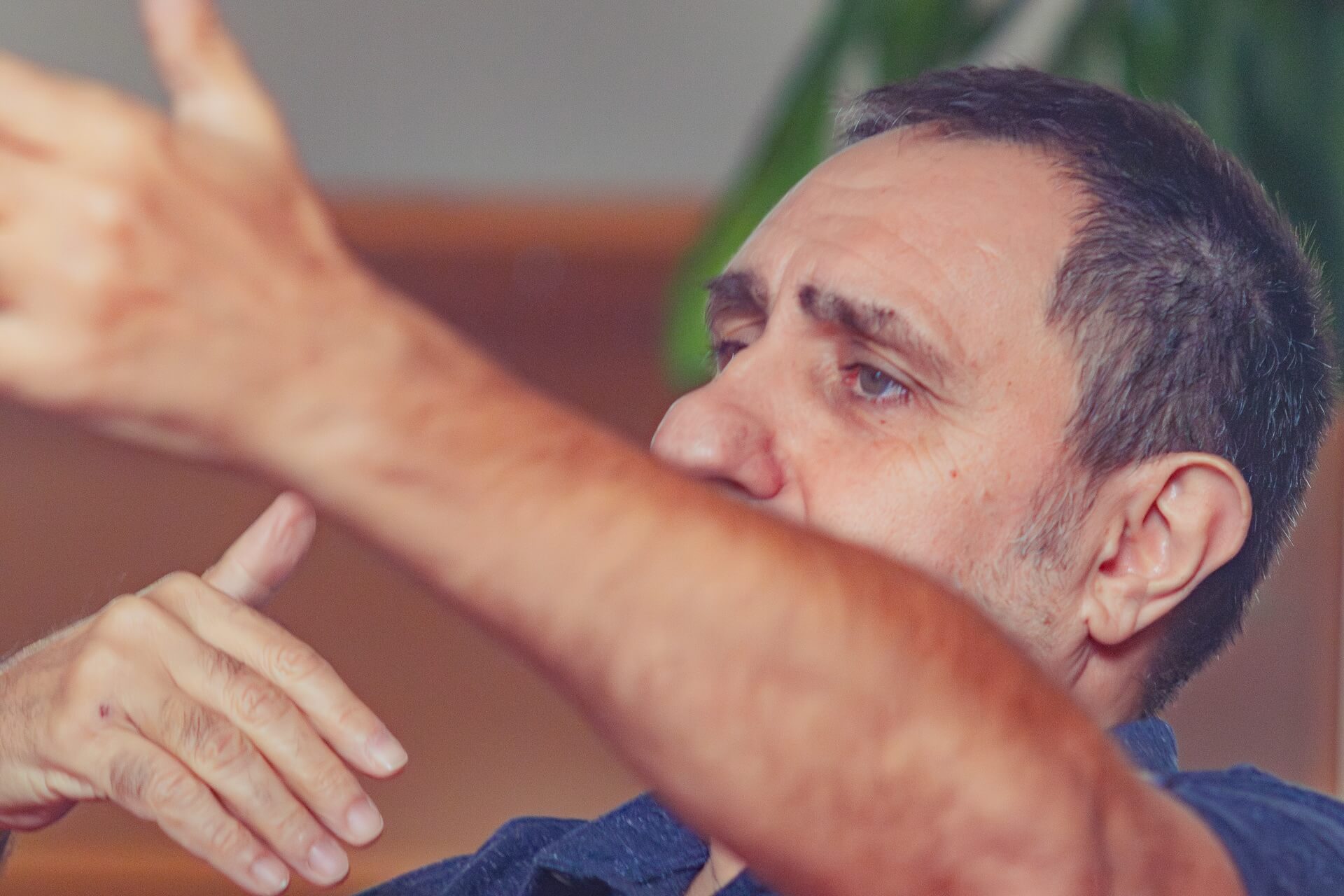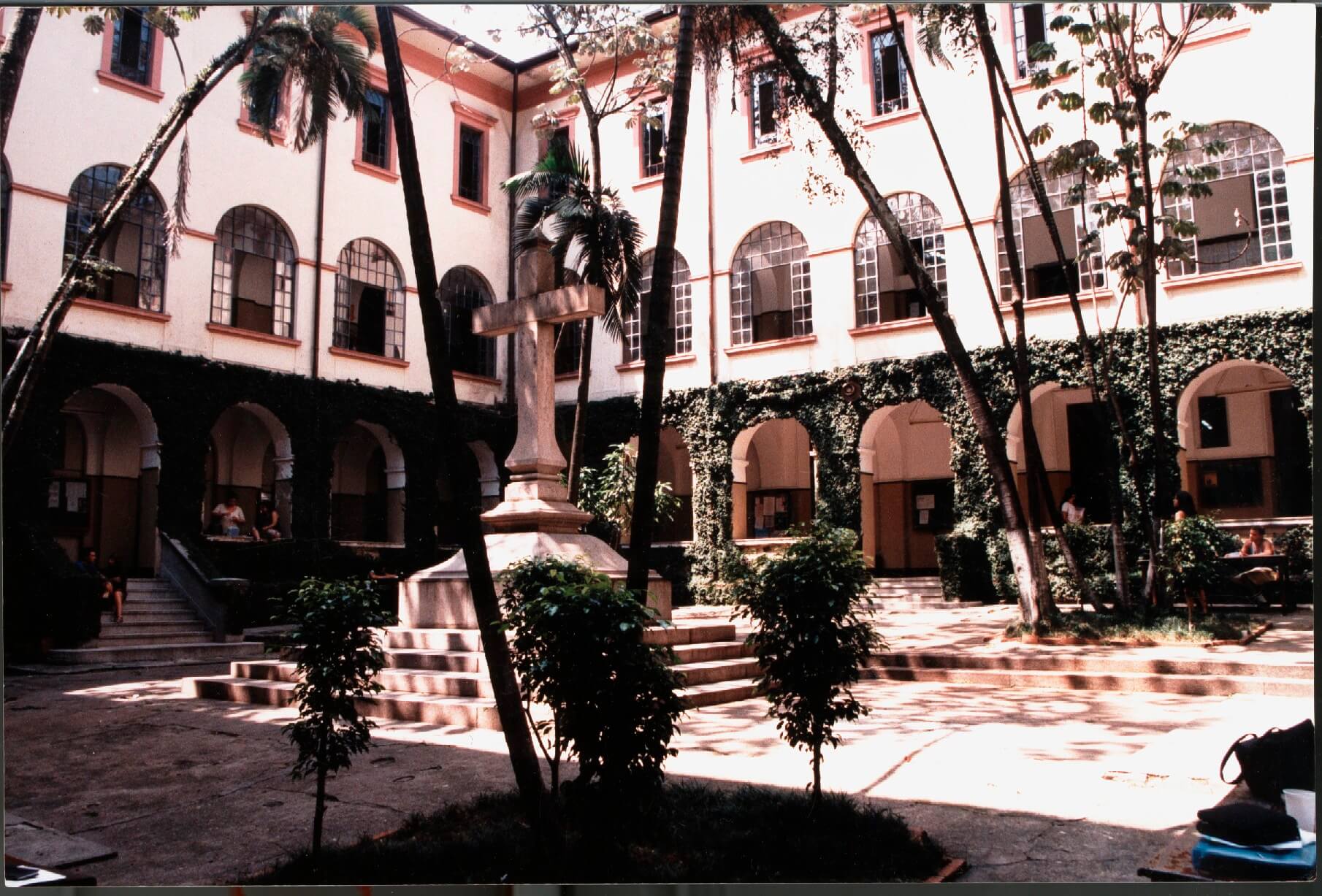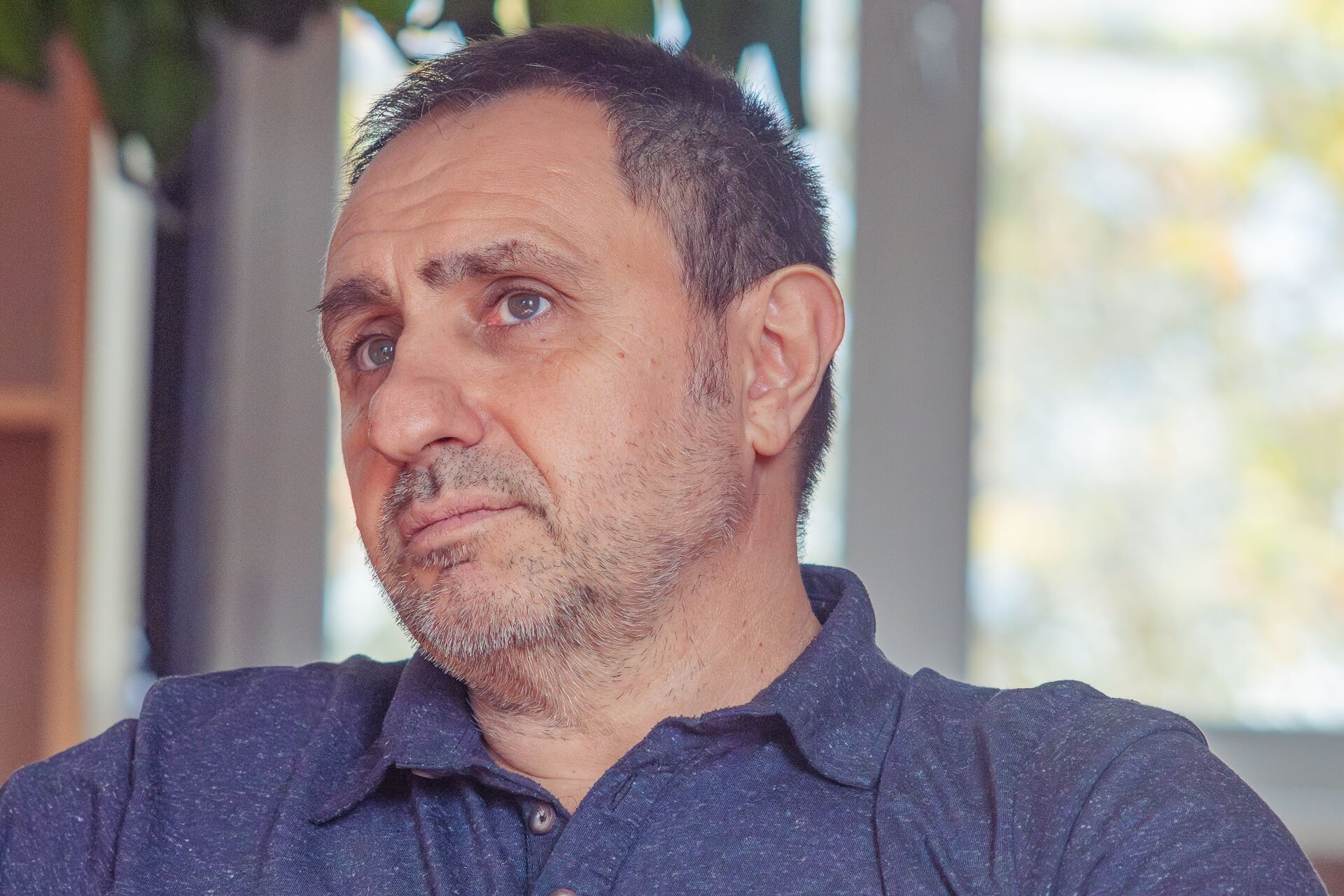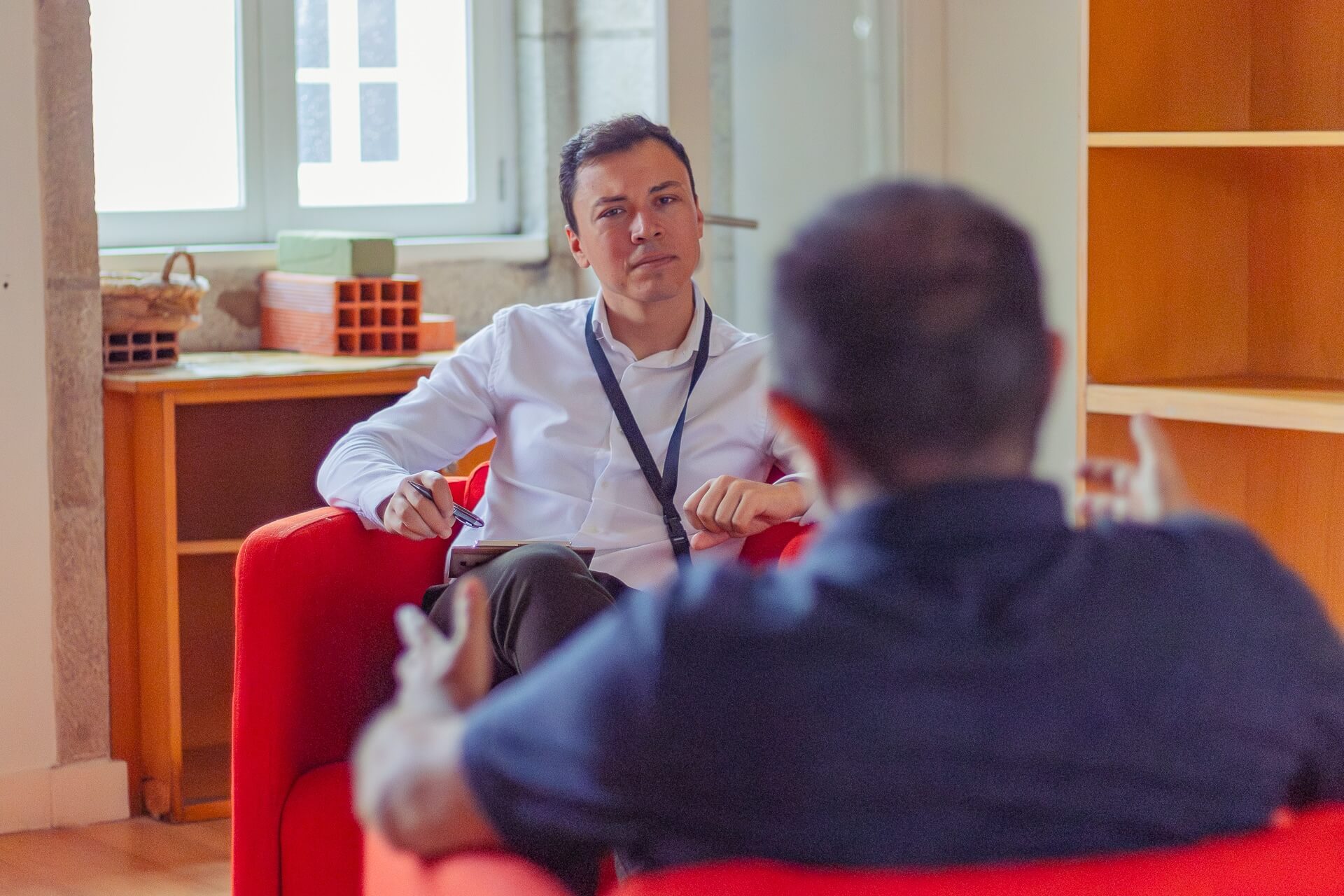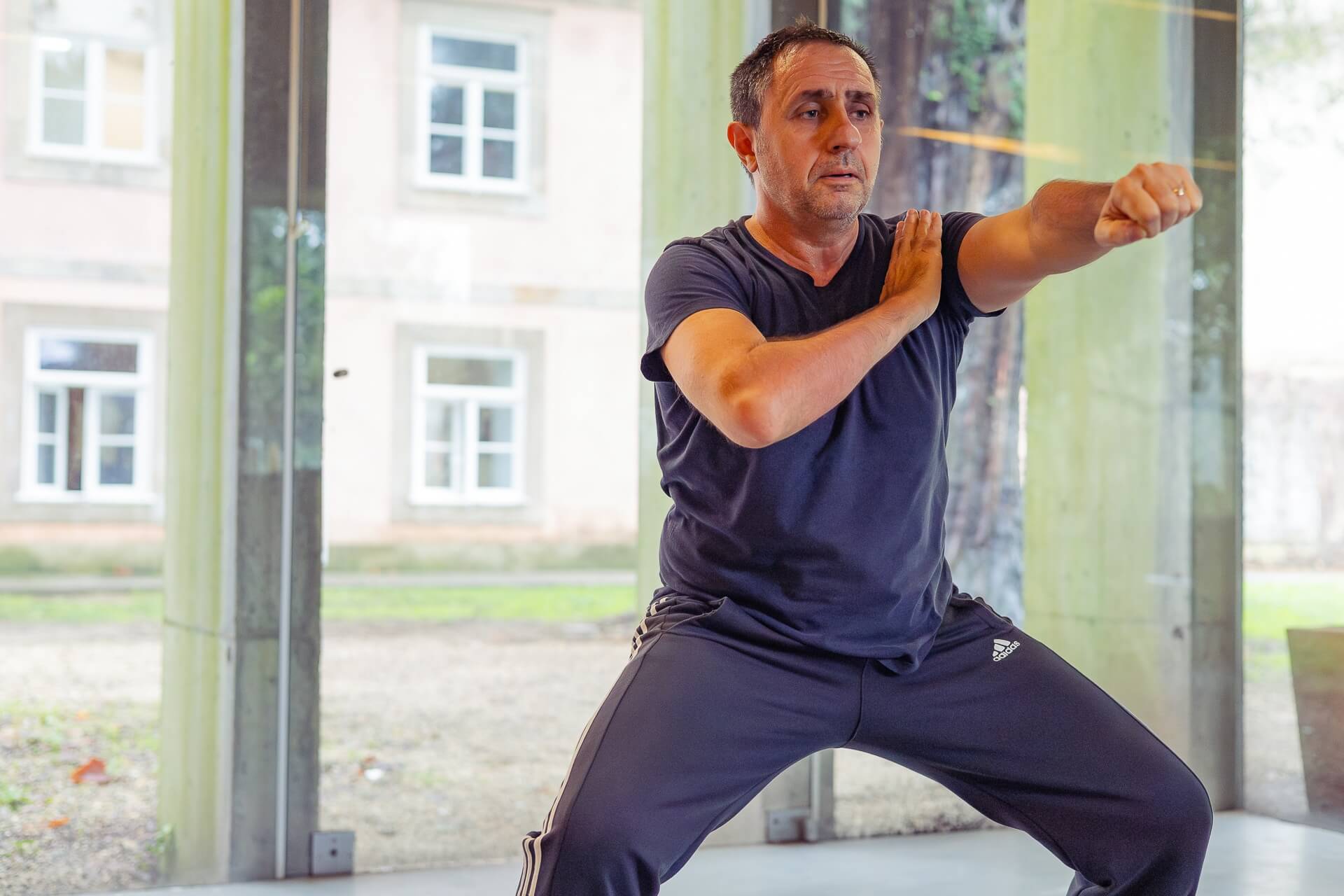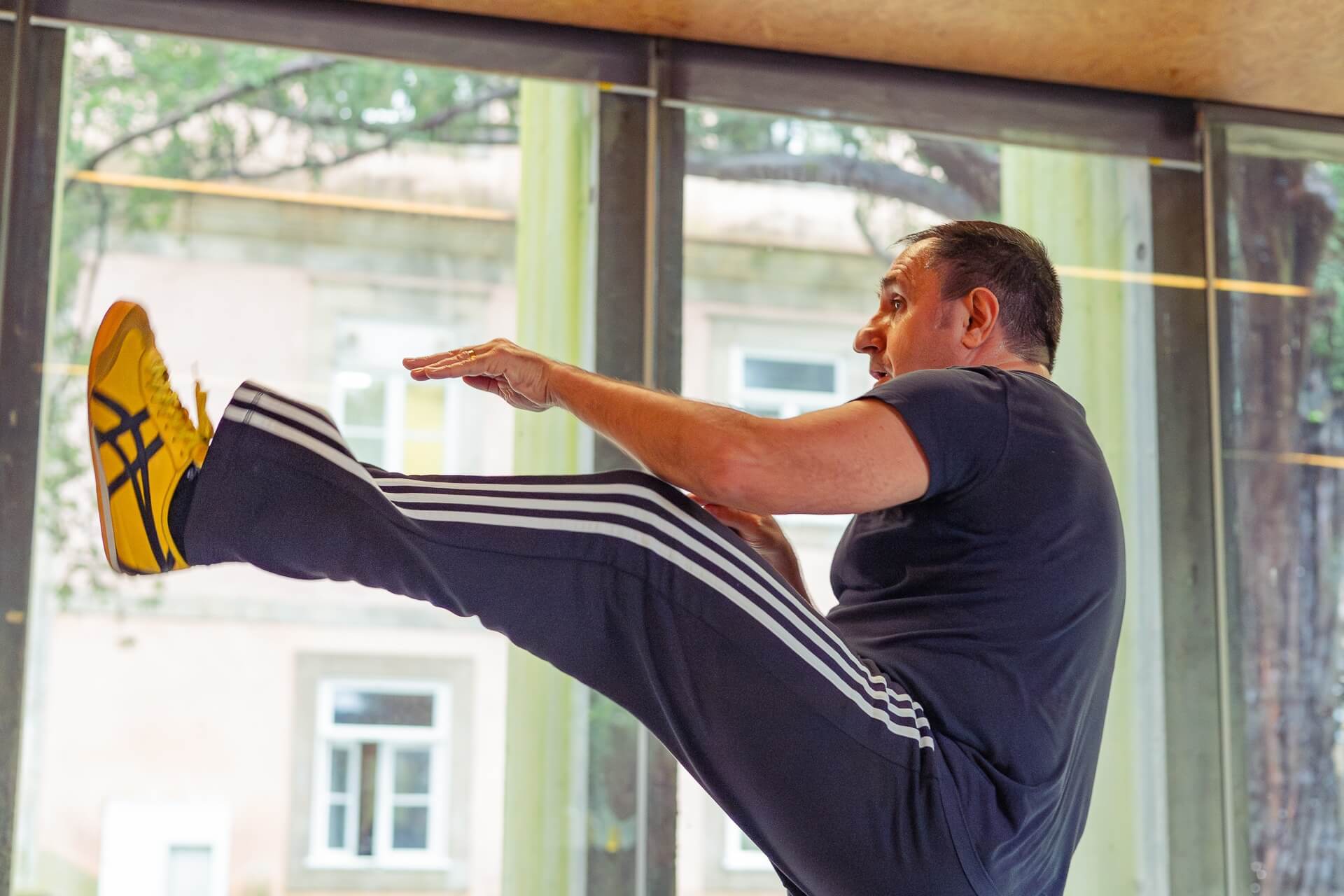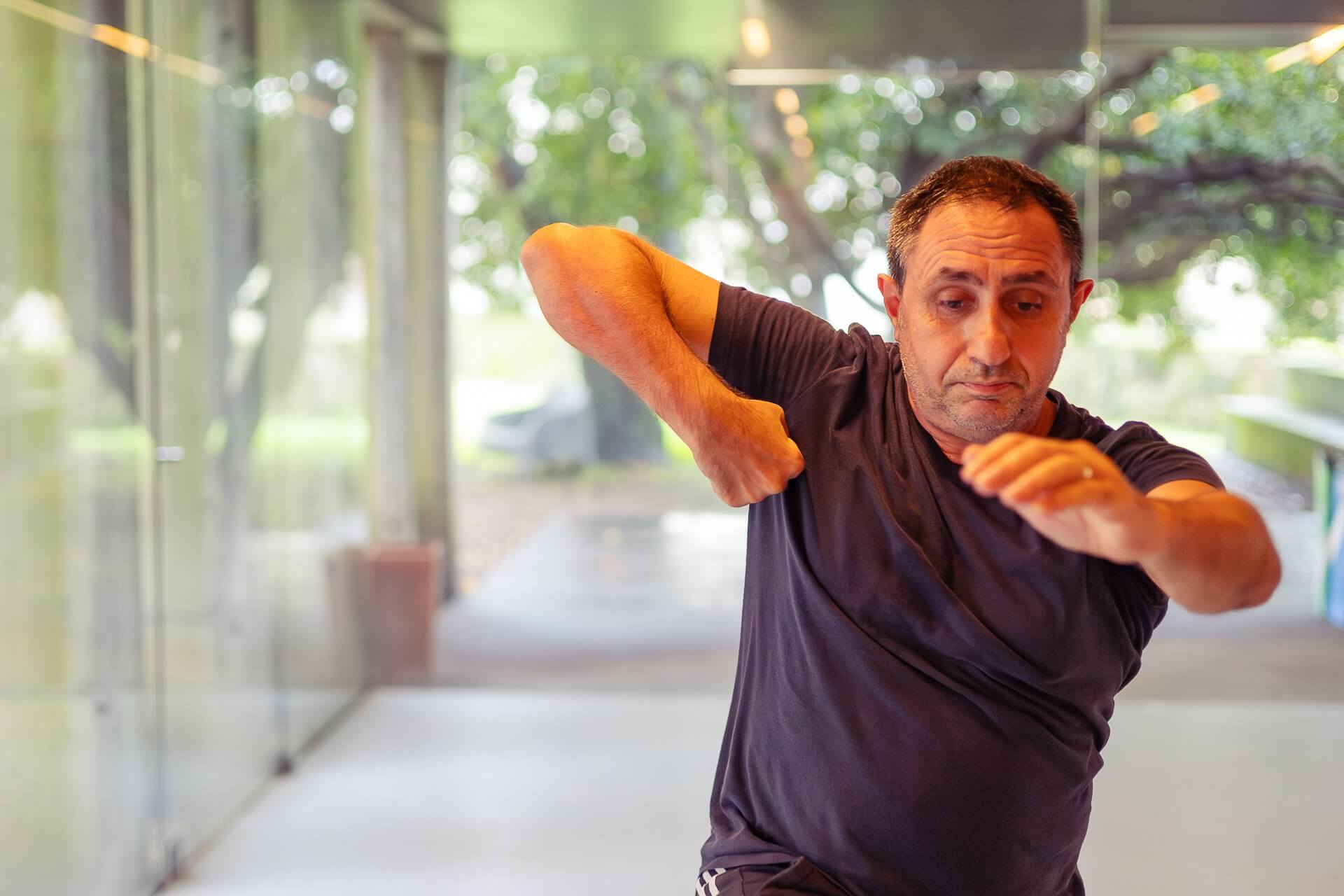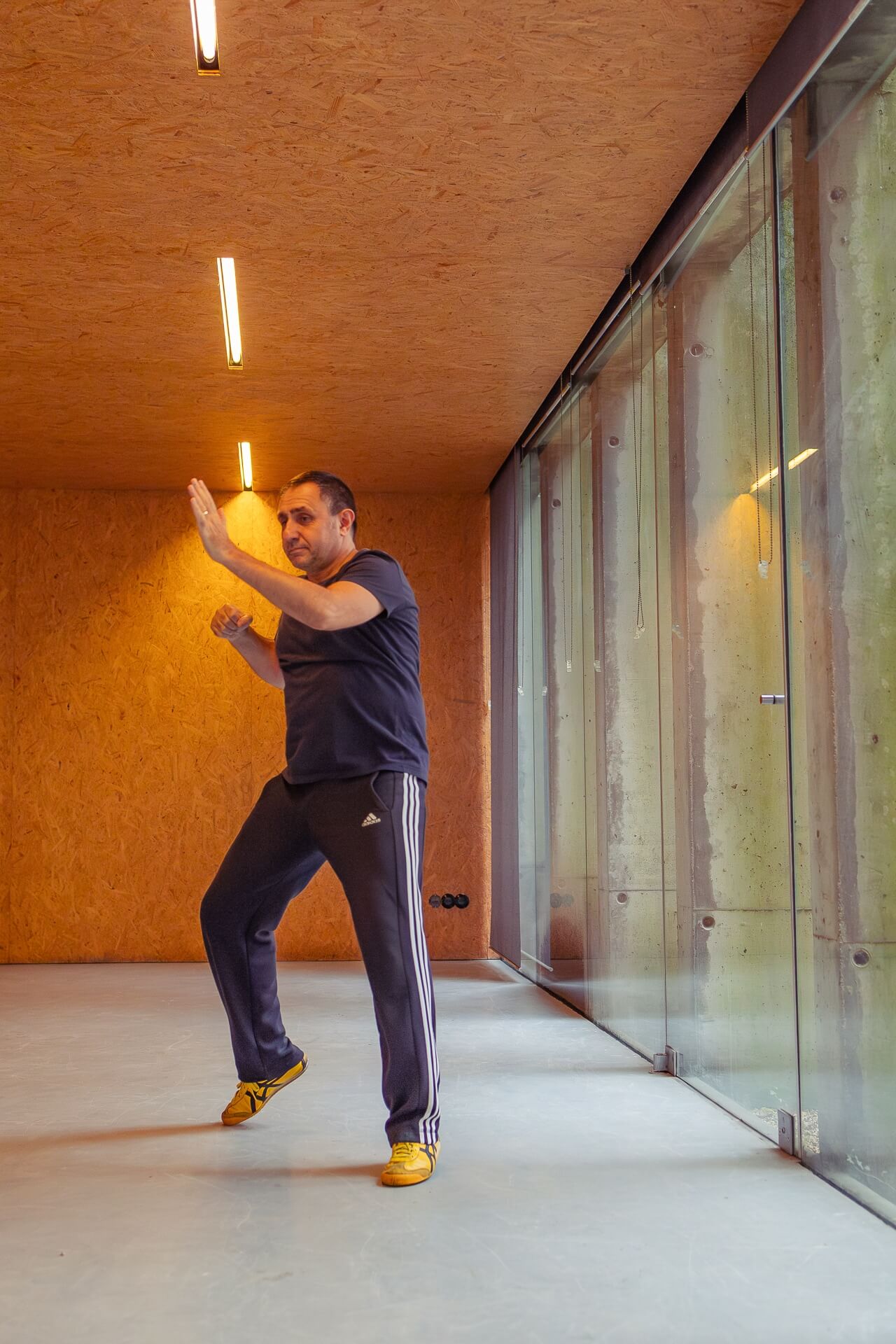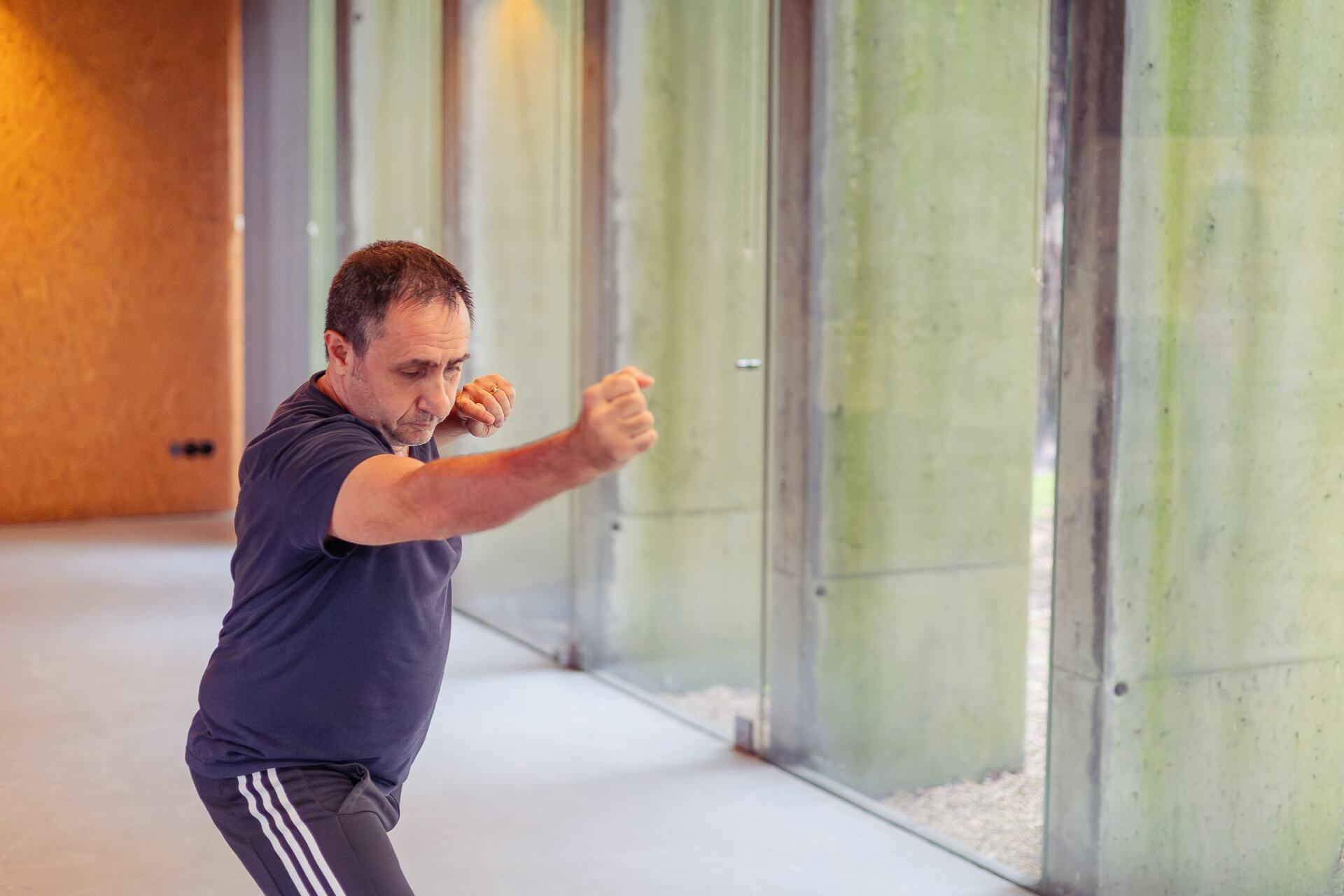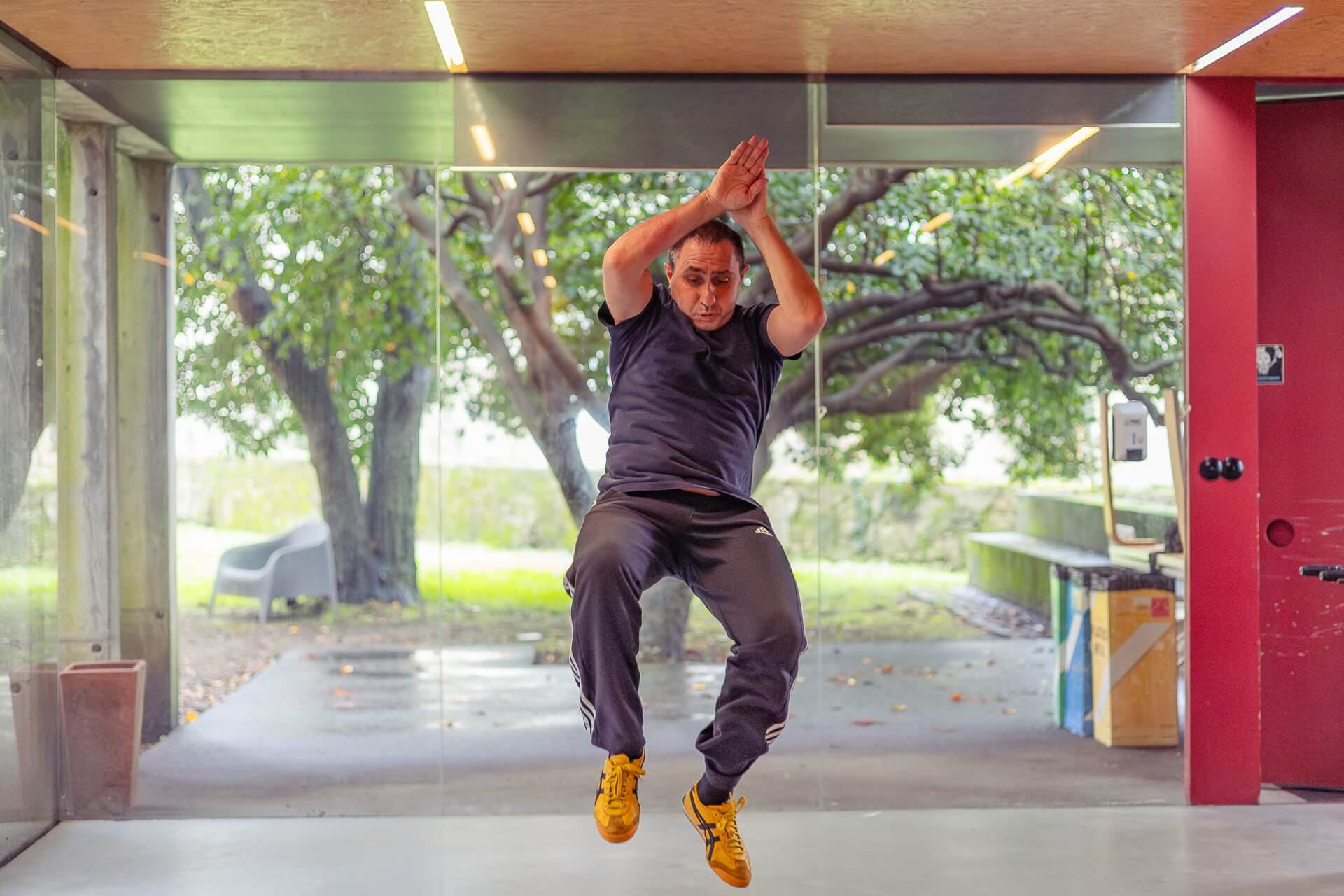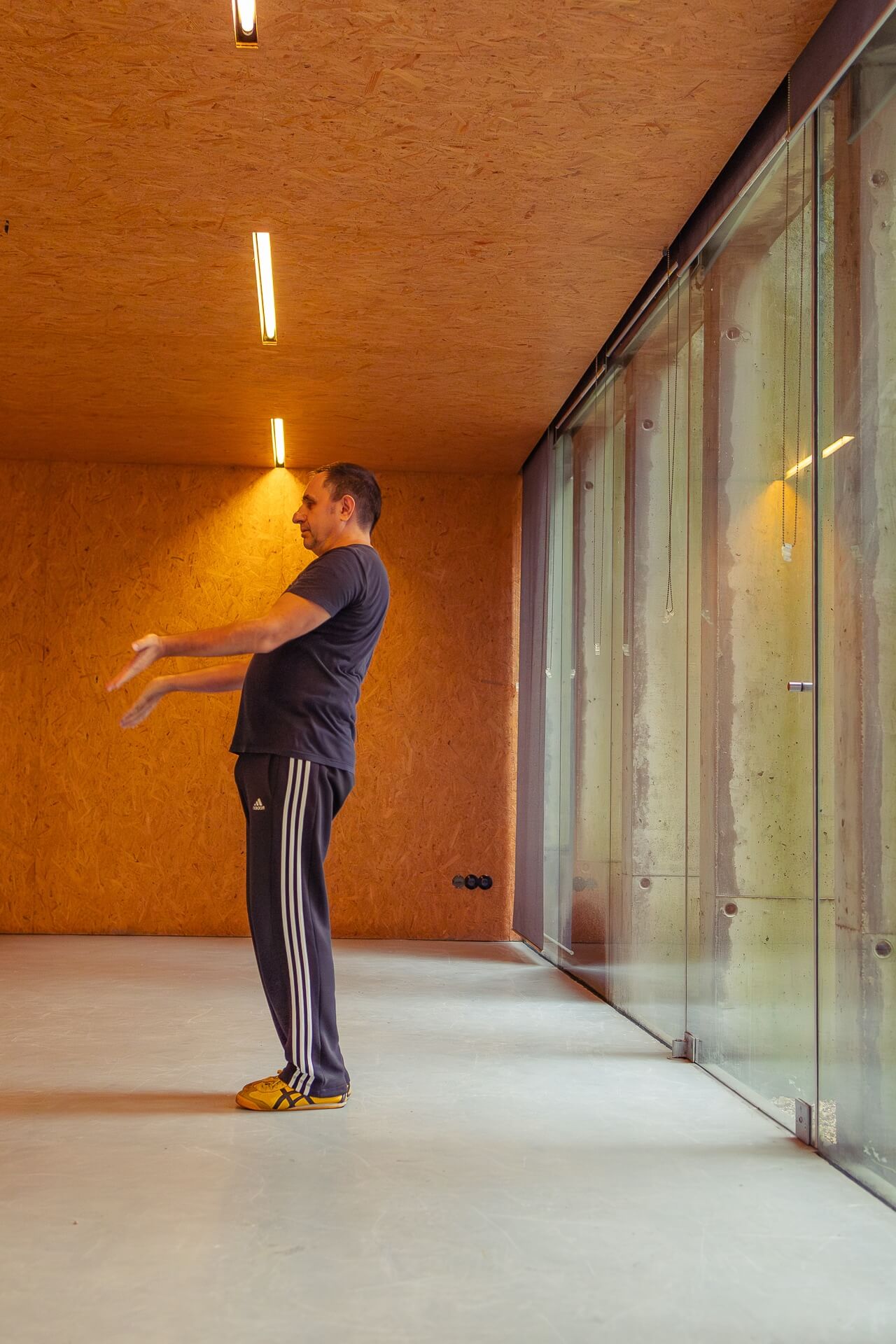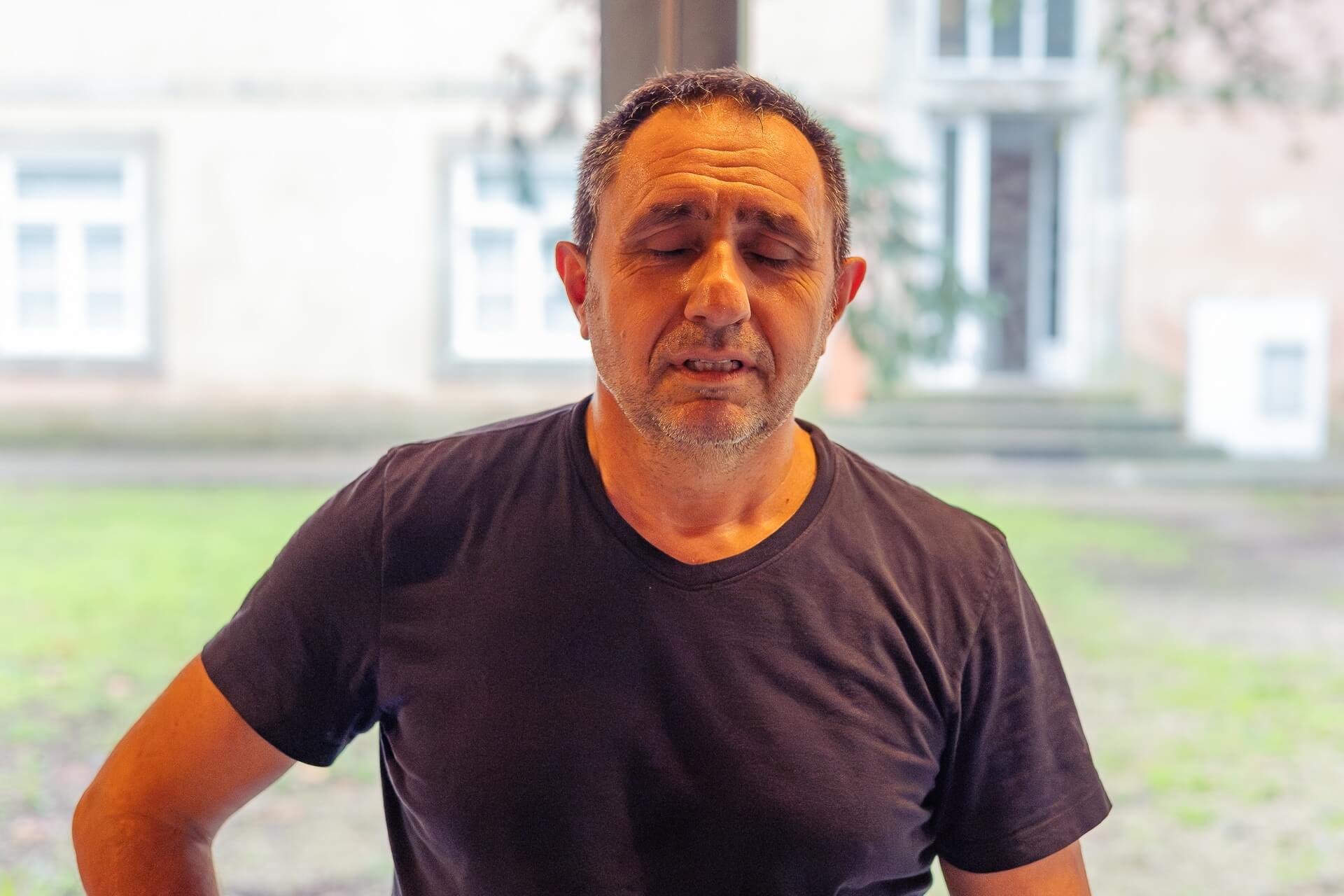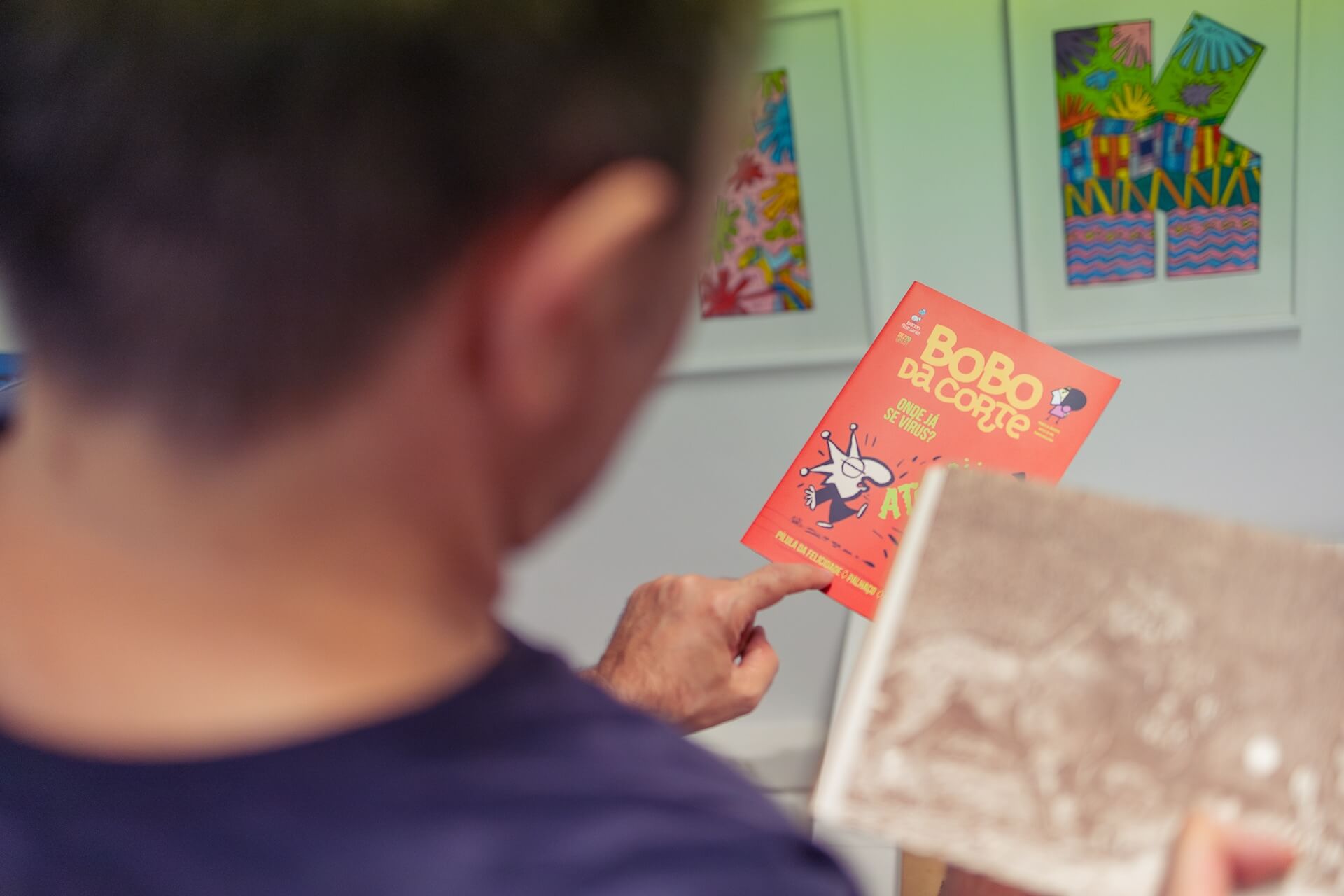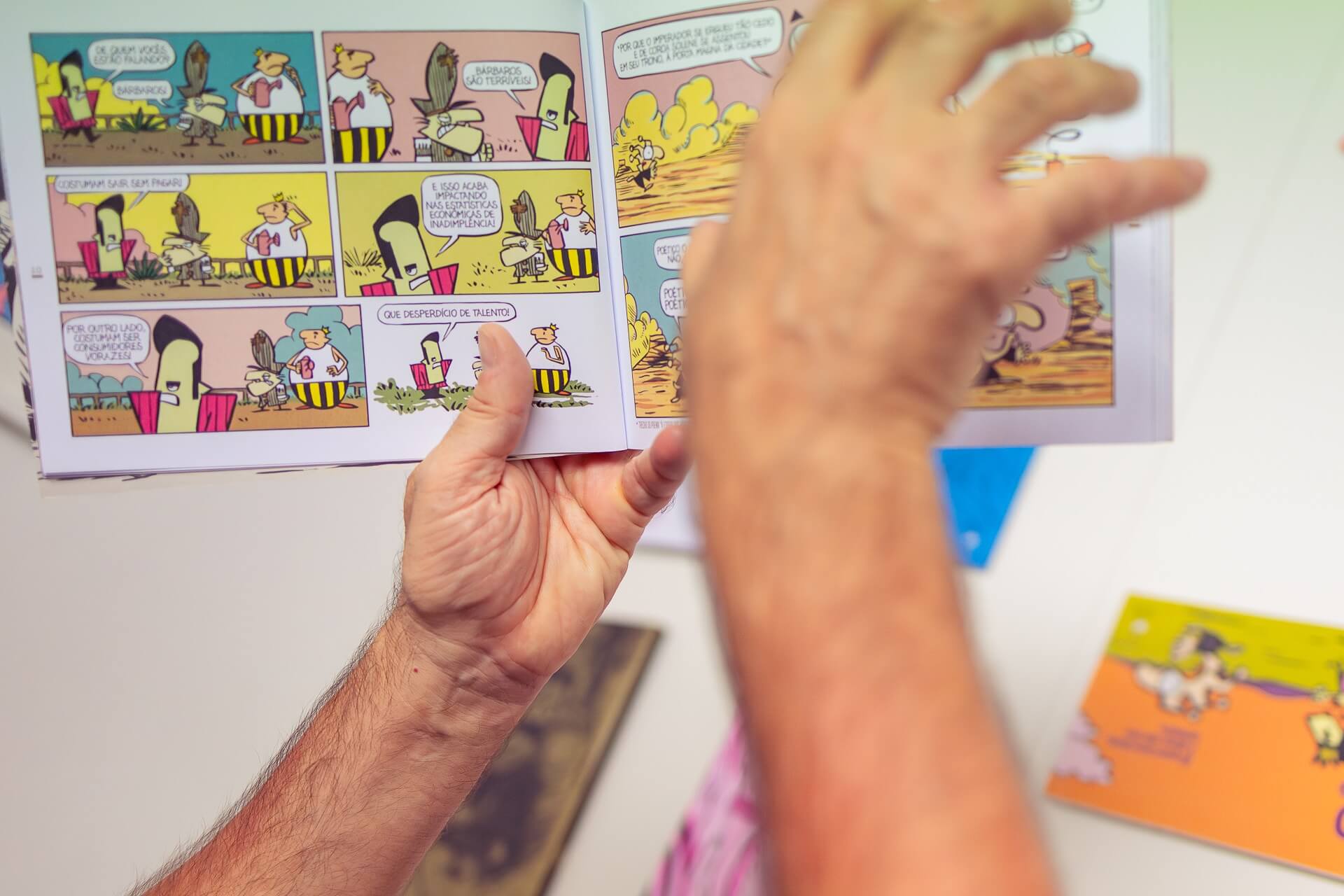Ruis Vargas: “I design with Kung Fu”
Ruis Vargas: “I design with Kung Fu”
Laika is a branding agency that was born with the purpose of representing a non-local, by the desire to create something that could be everywhere, and this is how the life of its founder, Ruis Vargas, has been: a little everywhere. In Porto, he found his 23rd home in 52 years after almost half a century of life in São Paulo. From the two-year-old drawings to the interest in martial arts films that have become a hobby and way of working, from his clients' trips to the couch to the hard unforeseen events that life has thrown at him, don't miss the story of the creator of iconic comics who has, at UPTEC Baixa, his 24th address. And if Laika can be everywhere, November's Out Of Office can only be read here.
What is Laika?
This whole story begins in 2000. I used to work in a communication agency in the No Media sector, and I wanted to work exclusively with graphic design. I was a little tired of the agency rhythm, which was a kind of crusher of people and was not focused on building brand projects but instead responding to immediate requests. In 2000, the information that reached us was that many people started making online work models. People in the Netherlands, Thailand, and the United States took the first steps because internet connections were slower than they are today. So I decided to try networking in different places, me and my original partner, who wanted to join me in the company and focus on graphic design. When we think of the business, each one of us in his office, we come up with the name “Laika”, which, cruelly – because the dog didn’t make it to space alive – represents a being who is in space, in a non-address, in a non-place, so we think of her as a representation of spatial mobility and another point of view on an object or idea—a different way of thinking. Then two more designers joined, one from programming, and we started working in different places in São Paulo, and that’s how this Laika concept was formed.
And what were Laika's early days like?
In 2002, we started to develop websites; we were solid in Flash from Macromedia, as one of our partners was very good with technology. He could make very compressed and speedy websites, which explored a lot of animation, soundtrack and other things. At the same time, we developed the branding part. The following year, and because of the projects being created, one was a dossier for the City of São Paulo, which was running as a candidate city for the 2012 Olympic Games. We did an extensive editorial project, with more than 600 pages, in a very demanding operation, which made us see that, with our space division, we were losing efficiency, so we went to work for our first headquarters, in the neighbourhood of Perdizes, in São Paulo. Then we moved to another place, where we stayed until 2021 when we came to Porto.
A return to the original essence of Laika...
Yes, with coming to Portugal, we reactivated the idea of being everywhere because although our headquarters are now in Porto, we continue to have activities and projects in Brazil, in Rio de Janeiro, Paraná, Bahia, Amapá, São Paulo, in addition to the projects we have in Portugal.
What does Laika do?
We always wanted to combine design with the construction of narratives, discourse, working with semiology, and the first projects we carried out allowed us to go down that path. Combining branding, design and narratives, because we didn’t want to develop the identity of the brands only from a graphic point of view, we wanted something more comprehensive. As I have a degree in Letters, it was possible to combine all these areas, to work on narratives, and writing as a basis for design, and it was there that we started to develop this way of thinking, always very humorous (laughs). Many of the projects carried this pinch of humour, much more with the written language than with the visual, but the visual was a translation of that language.
And what is your brand image?
We like to make works rich in illustration. Our portfolio has many brands created within this logic, with hand-made elements. At that time, the novelty was at the beginning of the impact of digital technologies and damn Clip Art (laughs), and few had the concern or desire to do things by hand. And that’s our main brand image, which still follows us. We prepare the entire language project, and the agencies that work for the brands will derive everything we outline regarding brand identity. We provide the tools, a very detailed brand book, so subsequent communication obeys this identity.
“Since we are not from here, we were looking for a community with which we had some affinity, and we found UPTEC”
Do you prefer to have total creative freedom or input in creating brand identity?
It’s the same because all the customers will pass by the couch.
By the couch?
Yes, by the couch (laughs). It is a tool for discursive and speech analysis. We conduct the conversation with the client in a very natural way to understand what they want. Once, we did this in a project with 20 people, so 20 different interviews, and in those interviews, we provoke (laughs) and analyse the answers more rationally. We had another case with six partners; five agreed with what they wanted for the brand, but the other did not. But this partner understood the business, and the others realised more about its profitability. So we bring that up, we give relevance to those contrasts, and the initial work is to understand what the client wants, their weaknesses and strengths, and point out a path; they are always part of the process.
How is Laika structured today?
I am the only remaining element from the beginning of Laika. We currently have three fixed and two transitional elements; I am not saying that they are fixed because they work on a project basis.
And how did you end up at UPTEC?
Cristiane, my partner, made contact with UPTEC. When we came here, we delivered the office in Brazil, and we were looking for a headquarters, but more than a headquarters. As we are not from here, we were looking for a community with which we had some affinity, and she found UPTEC. I had already researched UPTEC, I don’t think I even mentioned it to Cristiane, but she was the one who made the contact, namely with André Forte; that’s how it was.
What benefits has UPTEC brought you?
The main thing is not to be isolated. We can communicate with very different companies, and there is a much more extensive exchange of ideas. Being here has that benefit. We were very well received, it’s a fantastic community, we really enjoy being here, and there’s an amusing detail. When we arrived here, we immediately noticed the colour of the façade of the building, the internal part that faces the garden; it took us to our neighbourhood because it was close to the Pontifical Catholic University of São Paulo, which has a very similar building, so there was this familiarity. My current address is the 23rd address of my life. I’m used to change (laughs).
Pontifical Catholic University of São Paulo
You've been here for two years now. What can the Brazilian creative industry learn from the Portuguese one, and vice versa?
I don’t think about it too much because that’s the essence of Laika: to move between cultures. We are part of a Western culture, and there are many more affinities than divergences. The issue of regionalisation is no longer felt so much because communication is simultaneous; everything happens quickly, and what happens in one part of the world reaches everywhere very quickly. So, there is a kind of contamination; we no longer know where things come from. Although regionalisation still exists, it no longer exists in the same way as it did 20 years ago.
“To be in Porto is to be at a very strategic point”
What has been Laika's main achievement so far?
Adaptation. Our business model has been able to keep up with the transformations of the times and use our knowledge base to deal with it, with the news of the industry or supposed novelties, because many times, the novelties appear as new clothes of old things. At the age of 52, I have seen several generations of designers emerge and do things that, in essence, are repetitions of something that had already been done. It is challenging to create something that doesn’t have traces of the past, and that’s the real challenge. I don’t believe in novelty or originality because these are scarce, but combining elements is fundamental to creating more polyphonic narratives with several layers.
Laika's life has many awards, more than 25. Is it a highlight in your journey?
This recognition is essential because it comes from the pressure to put ourselves to the test, and it helps a more internationalised perception of Laika. It shows that we have notoriety outside of São Paulo and Brazil and are not only concentrated in these areas.
What's next? Should you continue betting on Portugal or think about other countries?
The purpose of coming to Portugal is also to be open to the rest of the world. It reminds me of a bike shop at the mouth of the Douro River, here in Porto, called “The last bike shop before New York” (laughs). To be in Porto is to be at a very strategic point. We are one of the last branding offices in this part of the planet. We are closer to South America, namely Brazil, where we continue to have a lot of projects, and because of this, I often travel there; we are closer to North America, which is a very positive aspect. But being at this point also allows us to expand to Europe’s opposite side. The challenge now is to think about how to develop branding, as we have developed in Portuguese but in English, French, Italian, Romanian, German. Why not? (laughs).
From an early age, he remembers drawing and enjoying telling stories. Time has proven that the talent he showed as a child has been well applied throughout his 35-year career, but time has shown that, in a short period and without anything making him predict, everything can change quickly. With a huge desire to live life, Ruis Vargas seeks to set a good example for his children and leave a kung fu mark on the world.
How were your first years of life?
I have a very powerful photographic memory, especially in the beginning, when I was a baby. I lived in a house in a neighbourhood on the outskirts of São Paulo, which was almost rural. In 1971, São Paulo was not yet a big metropolis. I remember being at home, sitting in a chair similar to this one, but in red Nappa leather, my father watching television, my mother in the backyard hanging clothes, and me, a baby, designing a car dashboard (laughs). I must have been about two years old, and I remember drawing; it was always present in me. That and storytelling, I’ve always loved storytelling, something that’s related to comics. My mother made me read a lot. She only studied until elementary school, but after age 50, she finished high school. She gave a lot of importance to reading because she didn’t have the opportunity to study much, so my childhood was always around books and comics, something that I collect to this day; I have a lot of comics at home, some rare.
And when did you go from reading comics to building comics?
Around the age of 10. In the beginning, I built narratives; I wrote comics, obviously inspired by what I read, but that was the beginning. In 1989, I left São Paulo and went to Recife, in Pernambuco, and that’s when I started doing strip comics, comic strips, and I had the opportunity to do an internship at a cultural newspaper, not earning anything but learning the profession, I was 17 years old. I started doing illustrations and made a comic strip for this newspaper, an idea that came together with the publisher, a cicerone, and a tourist guide from Recife. The character had a cap, and he said, “I’m going to place my cap on”, and the editor Goreti, who was my godmother in the profession, asked, “Place on what? It’s putting on your cap!”, and I said to her “Putting it on? It’s the chicken that puts it on” (laughs). It was hilarious to feel this culture shock right away because, in São Paulo, they said “place” the cap, but in Recife, they said “put” the cap. So, it was there that I started to understand graphic arts simultaneously. I developed comics and began to get into the profession, understand the printing process, make layouts by hand, and make final art.
And later you returned to your São Paulo...
Yes. Over the years, I made small publications in fanzines interested in comics, especially comic strips. In 1992, I started publishing in the USP newspaper – Jornal da Universidade de São Paulo- an incredible tabloid. At the time, the rector hired a team from Jornal da Tarde, a revolutionary newspaper, regarding layout. They revolutionised journalism, the concepts of the page; it wasn’t that bunch of blocks, but a bit of art united with journalism. At one point, the newspaper editor, Maria Lúcia Carneiro, said she would publish my strips. Subsequently, I began to publish on other sites. Cultural tabloids in São Paulo, for the SESC São Paulo magazine, which was already a colour magazine, always humour strips, but I didn’t publish for a long time because I stopped with comics when I started the office in 2002.
Did you have to choose?
Yes, because I either dedicated myself to Laika or made comics. This was followed by a period in which I didn’t draw comics for eight years.
And when did you come back?
In 2010. I was published in a magazine about the environment; I started posting in a newspaper of great circulation in Ribeirão Preto, a large city in the interior of São Paulo. In addition to the comic strips, I started making graphic novels, a type of comic published in book format, with longer stories from 2015 onwards, but these are not so humorous, they are even a little tense (laughs). André [Forte] even read it and found it “tense”! (laughs). I even have a curious episode. For many years, my strips were bought by publishers who produce textbooks. Large publishing houses that make public education books, specifically in the state of São Paulo, the largest and richest Brazilian state. I even had an episode with the son of an acquaintance who was surprised when he found out that I was the author of the Bobo da Corte strips because it was in the books he used for his studies.
“Sometimes I miss the noise of São Paulo”
And what led you to move here to Porto?
First of all, health. I have a Spanish-Brazilian friend. She lives here in Vila Nova de Gaia. She retired and came here and talked a lot about the city and Porto, which was beautiful (laughs). This was in 2010, 2011, so I always had this positive image. In 2016, my wife and I started thinking about leaving Brazil. “We have three children, we have the possibility of Italian citizenship on my father’s side, or Spanish citizenship on my mother’s side. What were the alternatives?” And then we thought, “Why not Portugal, where is my friend Núria?”. We thought about what would be best for our children, that they wouldn’t have to learn a new language, and that adaptation would be simpler. We also wanted a smaller city because we came from São Paulo, where the municipality alone has 20% more people than the whole of Portugal; it was chaos. It’s a very polluted city, and we weren’t in good health; I’m asthmatic, so I suffered from that.
What do you miss most about Brazil?
We miss meeting friends and family, but we can travel and be with them. Sometimes, I miss the noise of São Paulo. That hustle and bustle was part of my daily life, but I wouldn’t go back there because I like the silence here better. Sometimes, I’m in the apartment, and we don’t hear the neighbours; we hear the wind. It’s very windy where we live and looks like a horror movie (laughs). But it’s a very good silence. Porto’s pace is more human, while in São Paulo, everything is very fast-paced. It’s a tiring city. Now, what you have here and there is not a beautiful papaya at a lower price (laughs). I like beautiful papaya, plantains, I miss that (laughs).
So you don't have plans to return?
I don’t make any plans like that. I don’t know if I’ll stay in Porto until I’m 90 or if I’ll move to Singapore next year.
In your free time, what do you like to do?
There are a few things I like to do. I enjoy playing the tambourine; I’ve been playing since my youth. I’m not a professional, but I’ve been practising for a long time, it’s good for the arms too (laughs). I’m still doing the comics. It’s not a hobby; it’s more of a side project that I still have. On the weekend, I write the strips, draw them, and post them on my Instagram, where a few people follow me. I have about three ideas for graphic novels in my head that I still need to put on paper; they’re just in my head because my process is more extensive. I formulate the story in my head, tell it to myself, and only then do I begin to develop it. In my free time, I’m with my kids, as a family, we go out to eat. I really like to walk from the Ribeira area to the sea, to Matosinhos. It’s a very inviting city. I also enjoy maintaining our apartment.
Where did martial arts come into your life?
I practice, but I’ve had to stop since I came here. I practice Kung-Fu Mantis style. Kung-Fu is very different from Karate in Japan, where you have the most defined martial arts, with more protocols, while clans form the martial arts in China, with many different standards. It’s not even called Kung-Fu, it’s called Wushu. Kung-Fu is because of Bruce Lee, and Kung-Fu is a concept of working hard, of doing it well. When I do design, I do it with Kung-Fu. I design with Kung-Fu. I do it in a dedicated way, with hard work, it’s an idea that can be applied to everything.
“I want to take care of my health to live as long as possible”
And how did you come up with this taste for martial arts?
It came about for several reasons, but the main one was that I was very stressed. I grew up in very tense places, and I ended up becoming a stressed-out person, who worked in a stressful profession, with stressful bosses, stressful deadlines, and for an asthmatic, that’s the worst thing. Ever since I was little, I was in love with Kung-Fu movies, classics like Chamber 36, the Shaolin Temple, and they were on television in the 70s, and I was passionate about them, so martial arts always stuck in my head. When I was younger, I played a lot of futsal, a lot of field soccer; I even competed in amateur football for the Association of Publicists of São Paulo, where we were runners-up and third placed, I played right back. In college, I was an athletic worker, I was part of the Athletic Board of Directors, and in my faculty of philosophy, literature and human sciences at USP, the flag has a cat, which is the symbol of athletics that was designed by me in the 90s and is still used today (laughs). I’ve always been very attached to sports. Despite my size, I always played; I played a lot of non-competitive volleyball but at a better level. I even did some competitions, but when I turned 35, 36, I broke my hand playing and thought, “I don’t think I’m old anymore.”… And I could have broken my head! I was running along the side of the field, and I got a backrest that threw me, and I fell with my hand next to the wall. When I was in the hospital, I met a guy who also had a soccer-related injury, and he told me that the week before, a friend of his had died precisely the same way I fell, only instead of hitting his hand on the wall, he went with his head… He had a head injury and didn’t resist… That’s when I thought, “I have a small son, I’m going to get a less violent sport…” so I went to martial arts (laughs). It helped me learn how to breathe better and have more control and fluidity of my body.
What is most indispensable for you in life?
The family… my children, my wife. That’s indispensable for me. It’s what we build. We have the other family members, but the day-to-day is lived with them. It’s a tremendous support, a big family, with three children, a noisy family (laughs). It’s essential to have them by my side, not least because I was away from them for a year in the process of coming to Portugal. I spent a year here alone, in the middle of a complicated process with several bureaucratic problems. But I felt their support from a distance because we feel we are only okay if everyone is okay.
“These are two dates that are so close and so remarkable for two very different reasons”
You said earlier that you don't make big personal plans. Despite that, do you have any idea where you see yourself in five years?
No. I help my clients do it, but I don’t do it to myself, because I was widowed at the age of 37… The first love of my life, we projected the future a lot… Silvia was extremely healthy; she rarely had the flu, she never had anything. I could get the flu, but she never had anything, ever, ever. Until she developed leukaemia… absolutely random, due to a virus, Human Cell Lymphotropic Virus, HTLV, and the development of the virus was very rare, it happens in a ridiculous number of people all over the world… In less than six months, everything was over, everything had changed… And I had with my eldest son… Until I met my wife, who already had two children. It was a fresh start. There, I learned that it’s not worth thinking too much about the future beyond the basics, of course… educating children, preparing them for life…
A very costly lesson...
Undoubtedly… I want to take care of my health and live as long as possible. I don’t know where I’ll be living in five years, but I want to be healthy enough to continue creating. I’m an uninterrupted mind (laughs). Sometimes, I wake up having ideas, so I have to be healthy to do them. Not long ago, I went back to doing something I don’t like at all, which is going to the gym… Since I didn’t like it, I started practising martial arts, but after working six or seven hours, and with my shoulder beginning to complain… If it continues like this, I won’t be able to draw in ten years, so I need to take care of my health. Now, at work, I make projections because we’re talking about a company. Five years from now, I don’t know how big Laika will be, but I hope to develop projects here as inspiring as those we did in Brazil, something that is already starting to happen. I hope to make a cultural symbiosis to add a lot to Portugal.
What do you think is the biggest emergency of the moment?
Thinking about it even causes depression, because we see everything that is happening in the world… The environmental issue is very complex; the wars that follow each other lead to more investment in armaments instead of betting on the well-being of the lives of people who live below the poverty line. It’s a great stupidity of ours… But it’s possible to create dialogues, break down borders, and break down prejudices. I try not to be prejudiced.
What is your greatest virtue and your most significant flaw?
I don’t know if it’s a virtue, but I’m a very systematic person. If I’ve agreed to something with someone, and I have a deadline of up to x hour, I’m adamant. I’m more flexible if something is not in my control, because I know I can’t control everything. I always try to be honest, to comply with everything correctly. Even crossing the street, my wife and children laugh when I cross outside the crosswalk (laughs). It was a trait I inherited from my mother.
A favorite word?
There is a word that I like a lot, from a song by Candeia performed by the singer Clara Nunes, called Sindorere. It is a word that unfolds in Afro-Brazilian culture. One of the meanings of its use can be “let’s do it with joy”.
Do you have a date that is engraved in your memory?
I have a very curious date. I believe it’s possibly August 9, 2008. As my first wife was sick, she was already in the hospital, it was the last time I saw her, then she was isolated, I couldn’t accompany her, but before she said “You have to marry again! You’ve got to find someone! You’re too young, you’ve got to find someone, you’re not going to be alone!” I’d tell her to stop, and she’d insist I had to find someone. Then I met my current wife, and she even jokingly says that Silvia pushed us because our meeting probability was low. So I also keep the date I met Cristiane, my current wife. She never remembers the date we met, but I do (laughs). September 22, 2008, a little while after Silvia passed away. It was the first time I spoke to Cris and the last time I spoke to Silvia. These are two dates that are so close and so striking for two very different reasons. This series of events also connected my children. I have a biological one, I have both from Cris, and I could have one more from Silvia and another from Cris, but unfortunately, we lost those babies. Today, I could have five children, many children (laughs).
Finally, tell me three things you would like to do in your life.
So many things… I have a few stories to put on paper. The first is the sequel to Doces bárbaros, a graphic novel by the Jester, which originated in the newspapers Tribuna Impressa and A Cidade do interior de São Paulo, which came out on Sundays, a double “strip”, but as that newspaper ended, I was missing about four scenes to finish the whole story. So the people who read it wanted to know how the story ended! I left some hooks for the next story in this story, and I have this story in my head! It’s already here, consolidated in my head, and I know I must do it. I have to sit down and think and draw this story; it’s one of the things I have to do. If I die, someone will finish that story, I’ll possess someone’s body, and that person will draw for me (laughs)!
And two others?
I want my children to be autonomous and to know how to deal with frustration. Life is, basically, frustration. I wish I were 1.90m! Not to be big-nosed, not to be so white (laughs)! But I can’t, and we have to deal with it. And one of my dreams was to play drums, but it’s too complicated! Coordinating everything, arms, legs, is very complex, so I prefer to stick to the tambourine (laughs). But deep down, that’s it; I want to guide my children to a safe path and know they have tools that serve as a haven for them.
November 30th 2023
The exhibition “How to produce stripcomics and graphic novels without losing your friends” by Ruis Vargas can be visited at UPTEC Baixa, until January 25, 2024. To schedule a visit, contact xpo@uptec.up.pt, with the date you want.
